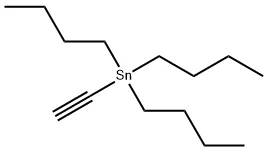- This topic is empty.
-
AuthorPosts
-
2025-09-12 at 10:59 am #86232
Tributylstannylacetylene (CAS No.: 994-89-8) is a highly valuable organotin compound widely applied in organic synthesis and materials science. With the molecular formula C14H28Sn and a molecular weight of 315.08 g/mol, this compound exhibits unique structural and chemical properties that make it indispensable in both academic research and industrial applications.
At room temperature, Tributylstannylacetylene appears as a liquid with a density of 1.089 g/mL at 25 °C, a refractive index of n20/D 1.476, and a boiling point of 70 °C at 0.2 mmHg. It has a flash point of 165 °F, is moisture-sensitive, and requires storage under sealed, dry conditions at –20 °C to maintain stability. In this blog post, SACH, a high purity fine chemical raw materials manufacturing factory, will share the chemical characteristics of organotin compound tributylstannylacetylene for sale, its synthesis, applications in organic synthesis, etc.
Chemical Characteristics of Organotin Compound Tributylstannylacetylene
The structural core of Tributylstannylacetylene (CAS No.: 994-89-8) integrates a tin atom with a butyl group and an acetylene moiety, enabling unique reactivity in organometallic transformations. It is not miscible with water, which enhances its stability in organic solvents, though this property necessitates careful handling.
The specific gravity of 1.089 and its sensitivity to moisture indicate that proper laboratory protocols must be followed during handling and storage. Its low boiling point under reduced pressure and moderate flash point also highlight its volatility and the need for controlled experimental conditions.

Synthesis of Organotin Compound Tributylstannylacetylene
The preparation of Tributylstannylacetylene (CAS No.: 994-89-8) can be achieved via two well-documented synthetic routes:
Method 1: From Tributyltin Chloride and Lithium Acetylene
In this pathway, tributyltin chloride reacts with lithium acetylene, producing Tributylstannylacetylene as the main product. This method is efficient for laboratory-scale synthesis and ensures a high-purity yield.
Method 2: From Tributyltin Hydride and Halogenated Hydrocarbons
Another method involves the reaction of tributyltin hydride with halogenated acetylenes such as iodoacetylene. Under carefully controlled reaction conditions, the desired organotin compound is obtained with good efficiency.
Both methods are widely referenced in organometallic synthesis, and each can be optimized depending on the intended application, whether in catalysis, material synthesis, or fine chemical production.
Applications of Tributylstannylacetylene in Organic Synthesis
One of the most significant uses of Tributylstannylacetylene (CAS No.: 994-89-8) is as a raw material for organic synthesis. It can participate in cross-coupling reactions and other transformations, enabling the preparation of complex molecules with high functional diversity.
* Synthetic Intermediate: The acetylene-tin bond serves as a reactive site for introducing alkyne groups into organic frameworks.
* Specialty Chemicals: It is often used as a precursor in the synthesis of unique organotin compounds that find applications in materials science and medicinal chemistry.
* Fine Chemical Development: Tributylstannylacetylene provides a versatile building block for developing new ligands, catalysts, and bioactive molecules.
Tributylstannylacetylene as Catalyst
Beyond being a synthetic intermediate, Tributylstannylacetylene also functions as a catalyst in certain organic transformations. Its organotin center can facilitate bond activation and accelerate reaction rates in processes such as radical-mediated coupling or cyclization reactions.
In laboratory and industrial contexts, researchers value its ability to enable efficient reaction pathways, reduce energy requirements, and increase selectivity in product formation.
Role of Tributylstannylacetylene in Pesticide Synthesis
Organotin compounds are historically important in pesticide development. Tributylstannylacetylene (CAS No.: 994-89-8) plays a role as an intermediate in the synthesis of tin-containing pesticide precursors. These intermediates can then be further modified into specialized pesticides with targeted biological activity.
By serving as a raw material for pesticide intermediates, Tributylstannylacetylene indirectly contributes to the agricultural sector, where highly specific and efficient crop protection agents are needed.
Material Synthesis and Industrial Applications
Tributylstannylacetylene is also an essential compound in materials science and polymer chemistry. For example:
* Organotin Stabilizers: It can act as a starting material in producing stabilizers for polymers such as PVC, extending product durability and improving thermal resistance.
* Specialty Materials: In certain niche materials, the unique structure of Tributylstannylacetylene helps introduce functional groups that improve performance in coatings, adhesives, and advanced composites.
These industrial applications highlight how this compound bridges the gap between fine organic synthesis and large-scale material engineering.
Safety and Storage Guidelines for Tributylstannylacetylene
Given its moisture sensitivity and volatility, safe handling of Tributylstannylacetylene (CAS No.: 994-89-8) is crucial. Recommended guidelines include:
* Storage: Keep sealed, dry, and stored in a freezer at –20 °C.
* Handling: Avoid exposure to air and moisture. Conduct operations under an inert atmosphere such as nitrogen or argon.
* Protective Equipment: Use gloves, goggles, and lab coats when handling the liquid to prevent direct contact.
* Fire Safety: With a flash point of 165 °F, fire risks are moderate, and proper laboratory fire precautions must be in place.
Adhering to these practices ensures the compound remains stable and safe for research and production purposes.
Why Tributylstannylacetylene Matters in Chemistry?
The importance of Tributylstannylacetylene lies in its dual role: both as a synthetic intermediate and as a functional reagent in advanced chemistry. Whether contributing to novel catalysts, pesticides, or polymer stabilizers, this compound is an indispensable part of the chemical industry.
As the demand for efficient, high-performance compounds grows, Tributylstannylacetylene will remain a cornerstone in organic chemistry research and industrial production.
Conclusion
From organic synthesis and catalysis to pesticide intermediates and material science, Tributylstannylacetylene (CAS No.: 994-89-8) is a versatile organotin compound that continues to prove its value across multiple fields. Its well-defined technical properties, reliable synthetic pathways, and broad range of applications make it a critical material in both laboratory and industrial settings.
-
AuthorPosts
- You must be logged in to reply to this topic.


